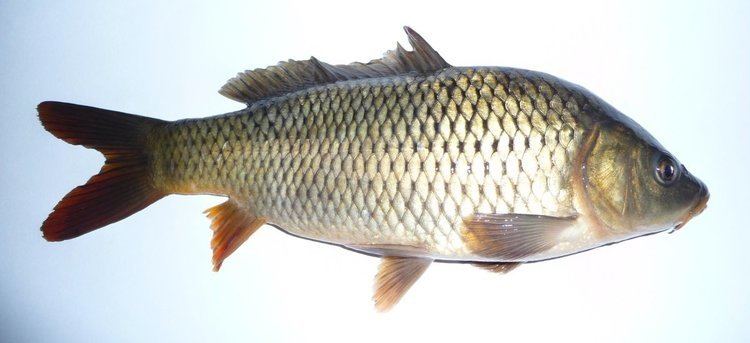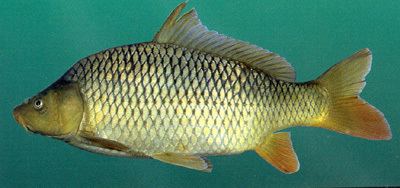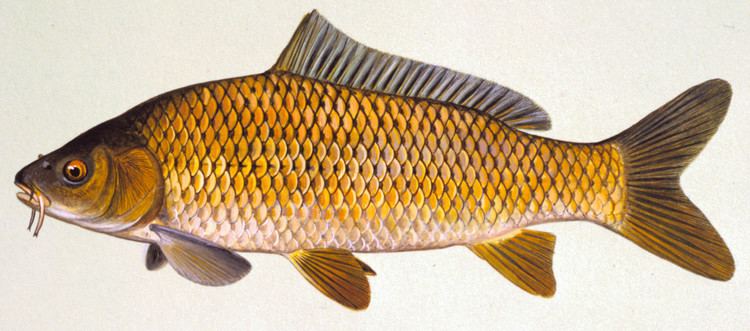Scientific name Cyprinus carpio Length 40 – 80 cm (Adult) | Phylum Chordata Genus Cyprinus Mass 2 – 14 kg | |
 | ||
Lifespan 20 years (In the wild, Canada population) Breeds Similar Carp, Carassius, Trout, Tilapia, Atlantic salmon | ||
Bank fishing for common carp
The common carp or European carp (Cyprinus carpio) is a widespread freshwater fish of eutrophic waters in lakes and large rivers in Europe and Asia. The native wild populations are considered vulnerable to extinction by the IUCN, but the species has also been domesticated and introduced into environments worldwide, and is often considered a destructive invasive species, being included in the list of the world's 100 worst invasive species. It gives its name to the carp family Cyprinidae.
Contents
- Bank fishing for common carp
- Bait fishing 76 white sucker and common carp fishing with worms
- Taxonomy
- History
- Physiology
- Habitat
- Diet
- Reproduction
- Predation
- Introduction into other habitats
- As food and sport
- References
Bait fishing 76 white sucker and common carp fishing with worms
Taxonomy
The two subspecies are:


A third subspecies, C. c. haematopterus (Amur carp) native to eastern Asia, was recognized in the past, but recent authorities treat it as a separate species under the name C. rubrofuscus. The common carp and various Asian relatives in the pure forms can be separated by meristics and also differ in genetics, but they are able to interbreed. Common carp can also interbreed with the common goldfish (Carassius auratus).
History

The common carp is native to Europe and Asia, and has been introduced to every part of the world except the poles. They are the third most frequently introduced species worldwide, and their history as a farmed fish dates back to Roman times. Carp are used as food in many areas, but are now also regarded as a pest in some regions due to their ability to out-compete native fish stocks. The original common carp was found in the inland delta of the Danube River about 2000 years ago, and was torpedo-shaped and golden-yellow in colour. It had two pairs of barbels and a mesh-like scale pattern. Although this fish was initially kept as an exploited captive, it was later maintained in large, specially built ponds by the Romans in south-central Europe (verified by the discovery of common carp remains in excavated settlements in the Danube delta area). As aquaculture became a profitable branch of agriculture, efforts were made to farm the animals, and the culture systems soon included spawning and growing ponds. The common carp's native range also extends to the Black Sea, Caspian Sea and Aral Sea.

Both European and Asian subspecies have been domesticated. In Europe, domestication of carp as food fish was spread by monks between the 13th and 16th centuries. The wild forms of carp had already reached the delta of the Rhine in the 12th century, probably with some human help. Variants that have arisen with domestication include the mirror carp, with large, mirror-like scales (linear mirror – scaleless except for a row of large scales that run along the lateral line; originating in Germany), the leather carp (virtually unscaled except near dorsal fin), and the fully scaled carp. Koi carp (錦鯉 (nishikigoi) in Japanese, 鯉魚 (pinyin: lĭ yú) in Chinese) is a domesticated ornamental variety that originated in the Niigata region of Japan in the 1820s, but its parent species are likely the East Asian carp, possibly C. rubrofuscus.
Physiology
Wild common carp are typically slimmer than domesticated forms, with body length about four times body height, red flesh, and a forward-protruding mouth. Common carp can grow to very large sizes if given adequate space and nutrients. Their average growth rate by weight is about half the growth rate of domesticated carp They do not reach the lengths and weights of domesticated carp, which (range, 3.2–4.8 times) can grow to a maximum length of 120 centimetres (47 in), a maximum weight of over 40 kilograms (88 lb), and an oldest recorded age of 65 years, but reliable information seems to exist about nishikigoi of over 100 years. The largest recorded carp, caught by an angler in January 2010 at Lac de curtons (Rainbow Lake) near Bordeaux, France, weighed 42.6 kilograms (94 lb). The largest recorded carp, caught by British angler, Colin Smith, in 2013 at Etang La Saussaie Fishery, France, weighed 45.59 kilograms (100.5 lb). The average size of the common carp is around 40–80 cm (15.75-31.5 inches) and 2–14 kg (4.5-31 lb).
Like other cyprinids, common carp have been observed to be exceptional at leaping out of the water when threatened by predators, or frightened by passing watercraft.
Habitat
Although tolerant of most conditions, common carp prefer large bodies of slow or standing water and soft, vegetative sediments. As schooling fish, they prefer to be in groups of five or more. They naturally live in temperate climates in fresh or slightly brackish water with a pH of 6.5–9.0 and salinity up to about 0.5%, and temperatures of 3 to 35 °C (37–95 °F). The ideal temperature is 23 to 30 °C (73–86 °F), with spawning beginning at 17 to 18 °C (63–64 °F); they easily survive winter in a frozen-over pond, as long as some free water remains below the ice. Carp are able to tolerate water with very low oxygen levels, by gulping air at the surface.
Diet
Common carp are omnivorous. They can eat a herbivorous diet of water plants, but prefer to scavenge the bottom for insects, crustaceans (including zooplankton), crawfish, and benthic worms.
Reproduction
An egg-layer, a typical adult female can lay 300,000 eggs in a single spawn. Although carp typically spawn in the spring, in response to rising water temperatures and rainfall, carp can spawn multiple times in a season. In commercial operations, spawning is often stimulated using a process called hypophysation, where lyophilized pituitary extract is injected into the fish. The pituitary extract contains gonadotropic hormones which stimulate gonad maturation and sex steroid production, ultimately promoting reproduction.
Predation
A single carp can lay over a million eggs in a year, yet their population remains the same, so the eggs and young perish in similarly vast numbers. Eggs and fry often fall victim to bacteria, fungi, and the vast array of tiny predators in the pond environment. Carp which survive to juvenile are preyed upon by other fish such as the northern pike and largemouth bass, and a number of birds (including cormorants, herons, goosanders, and ospreys) and mammals (including otter and mink).
Introduction into other habitats
Common carp have been introduced to most continents and some 59 countries. In absence of natural predators or commercial fishing they may extensively alter their environments due to their reproductive rate and their feeding habit of grubbing through bottom sediments for food. In feeding, they may destroy, uproot, disturb and eat submerged vegetation, causing serious damage to native duck, such as canvasbacks, and fish populations.
In Victoria, Australia, common carp has been declared as noxious fish species, the quantity a fisher can take is unlimited. In South Australia, it is an offence for this species to be released back to the wild. An Australian company produces plant fertilizer from carp.
Efforts to eradicate a small colony from Tasmania's Lake Crescent without using chemicals have been successful, but the long-term, expensive and intensive undertaking is an example of both the possibility and difficulty of safely removing the species once it is established. One proposal, regarded as environmentally questionable, is to control common carp by deliberate exposing them to carp-specific koi herpes virus with its high mortality rate. The CSIRO has developed a technique for genetically modifying carp so that they only produce male offspring. This daughterless carp method shows promise for totally eradicating carp from Australia's waterways.
Common carp were brought to the United States in 1831. In the late 19th century, they were distributed widely throughout the country by the government as a food-fish, but they are no longer prized as a food-fish. As in Australia, their introduction has been shown to have negative environmental consequences, and they are usually considered to be invasive species. In Utah Lake Utah, the common carp's population is expected to be reduced by 75% by using nets to catch millions of them and either give them to people who will eat them or processing them into fertilizer. This, in turn, will give the native June sucker a chance to recover its declining population. Another method is by trapping them in tributaries they use to spawn with seine nets and exposing them to rotenone. This method has shown to reduce their impact within 24 hours and greatly increase the native vegetation and desirable fish species. This also leaves the baby carp easily preyed upon by native fish.
Common carp are believed to have been introduced into the Canadian province of British Columbia from Washington. They were first noted in the Okanagan Valley in 1912, as was their rapid growth in population. Carp are currently distributed in the lower Columbia (Arrow Lakes), lower Kootenay, Kettle (Christina Lake), and throughout the Okanagan system.
As food and sport
Cyprinus carpio is the number one fish of aquaculture. The annual tonnage of common carp produced in China alone, not to mention the other cyprinids, exceeds the weight of all other fish, such as trout and salmon, produced by aquaculture worldwide. Roughly three million tonnes are produced annually, accounting for 14% of all farmed freshwater fish in 2002. China is by far the largest commercial producer, accounting for about 70% of carp production. Carp is eaten in many parts of the world both when caught from the wild and raised in aquaculture. In Central Europe, it is a traditional part of a Christmas Eve dinner.
Hungarian Fisherman's soup, a specially prepared fish soup of carp alone or mixed with other freshwater fish, is part of the traditional meal for Christmas Eve in Hungary along with stuffed cabbage and poppy seed roll and walnut roll. A traditional Czech Christmas Eve dinner is a thick soup of carp's head and offal, fried carp meat with potato salad or boiled carp in black sauce. In some Czech families, the carp is not killed, but after Christmas returned to a river or pond. A Slovak Christmas Eve dinner is quite similar, with soup varying according to the region and fried carp as the main dish. In Western Europe, the carp is cultivated more commonly as a sport fish, although there is a small market as food fish. Carp are mixed with other common fish to make gefilte fish, popular in Jewish cuisine.
Common carp are extremely popular with anglers in many parts of Europe, and their popularity as quarry is slowly increasing among anglers in the United States (though destroyed as pests in many areas), and southern Canada. Carp are also popular with spear, bow, and fly fishermen.
The Romans farmed carp and this pond culture continued through the monasteries of Europe and to this day. In China, Korea and Japan, carp farming took place as early as the Yayoi Period (c. 300 BC – 300 AD).
Carp eggs, used for caviar, are increasingly popular in the United States.
